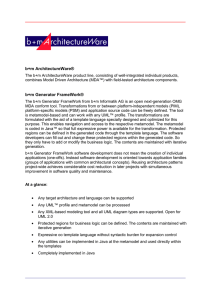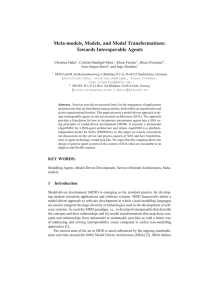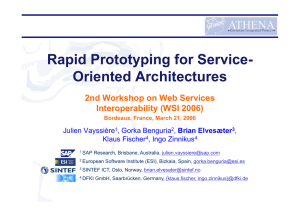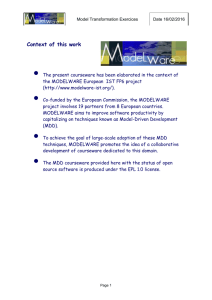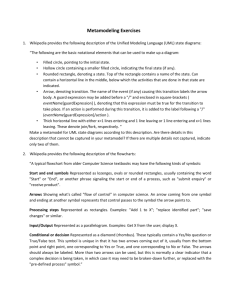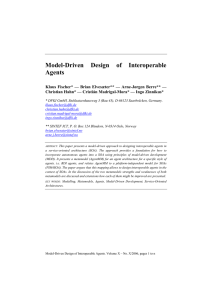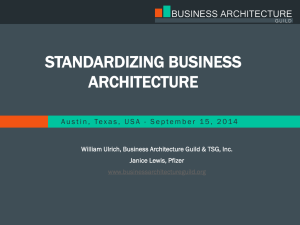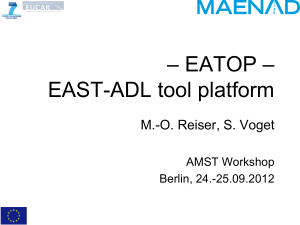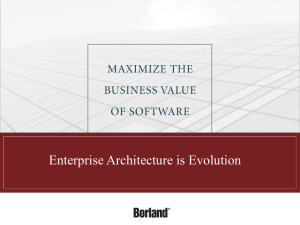1 A Platform Independent Model for Service Oriented Architectures
advertisement
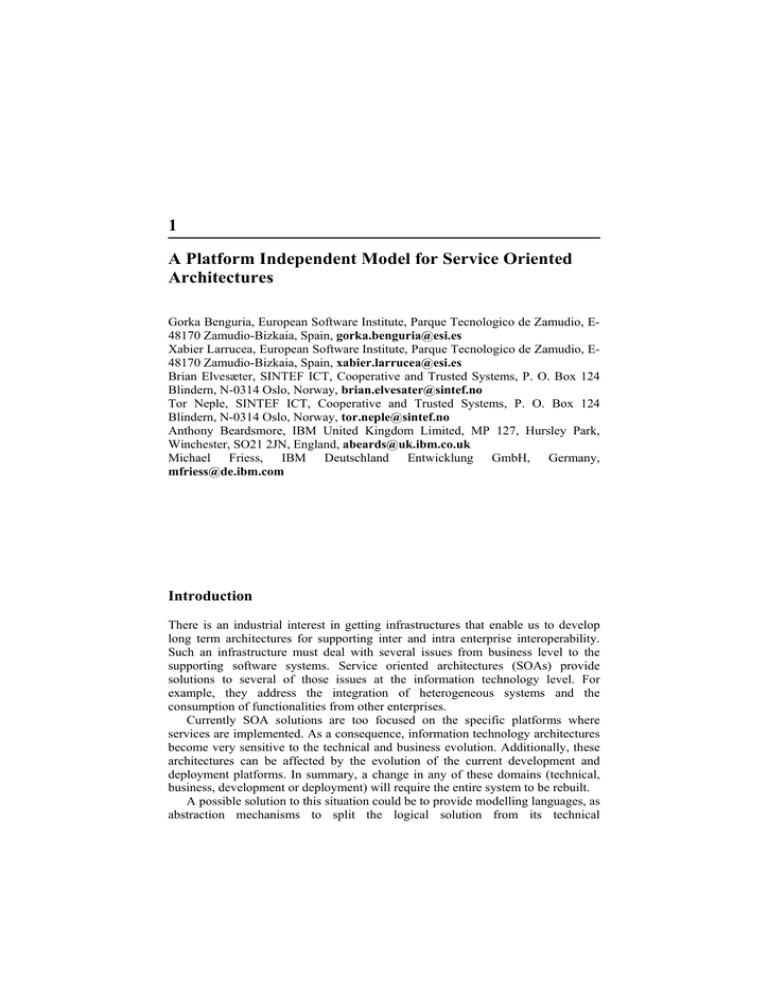
1 A Platform Independent Model for Service Oriented Architectures Gorka Benguria, European Software Institute, Parque Tecnologico de Zamudio, E48170 Zamudio-Bizkaia, Spain, gorka.benguria@esi.es Xabier Larrucea, European Software Institute, Parque Tecnologico de Zamudio, E48170 Zamudio-Bizkaia, Spain, xabier.larrucea@esi.es Brian Elvesæter, SINTEF ICT, Cooperative and Trusted Systems, P. O. Box 124 Blindern, N-0314 Oslo, Norway, brian.elvesater@sintef.no Tor Neple, SINTEF ICT, Cooperative and Trusted Systems, P. O. Box 124 Blindern, N-0314 Oslo, Norway, tor.neple@sintef.no Anthony Beardsmore, IBM United Kingdom Limited, MP 127, Hursley Park, Winchester, SO21 2JN, England, abeards@uk.ibm.co.uk Michael Friess, IBM Deutschland Entwicklung GmbH, Germany, mfriess@de.ibm.com Introduction There is an industrial interest in getting infrastructures that enable us to develop long term architectures for supporting inter and intra enterprise interoperability. Such an infrastructure must deal with several issues from business level to the supporting software systems. Service oriented architectures (SOAs) provide solutions to several of those issues at the information technology level. For example, they address the integration of heterogeneous systems and the consumption of functionalities from other enterprises. Currently SOA solutions are too focused on the specific platforms where services are implemented. As a consequence, information technology architectures become very sensitive to the technical and business evolution. Additionally, these architectures can be affected by the evolution of the current development and deployment platforms. In summary, a change in any of these domains (technical, business, development or deployment) will require the entire system to be rebuilt. A possible solution to this situation could be to provide modelling languages, as abstraction mechanisms to split the logical solution from its technical 2 Book Title implementation, that enables the definition of service architectures independently from the used specific platforms. A modelling language raising the level of abstraction allows us to share models and provides a capability to generate platforms specific assets (Models, code, standard documents). Unfortunately nowadays, there are no modelling languages based on service aspects, and able to set aside technical concerns in this way. There are existing general purpose modelling languages such as UML [1] (Unified Modeling Language). UML is a standard for software system modelling. It is able to represent any kind of software system, from embedded software to enterprise applications. To allow this flexibility UML provides a set of general elements applicable to any situation such as classes or relationships. When we try to model a SOA, we could find ourselves in a situation where everything is a class, a provider is a class, a service is a class, a registry is a class, etc, this could make the models difficult to understand and use. In addition UML provides facilities to specialize UML for a specific domain as so-called UML profiles. But frequently, these mechanisms are not able to represent the semantics behind the domain concepts. In the context of ATHENA project (Further details of the ATHENA project are provided latter in this paper) we have developed a metamodel for SOA. This metamodel allows us to define a platform independent model (PIM). This metamodel consists of a set of essential aspects for SOA. These aspects are service, process, information and quality of service. This paper presents the challenge of developing a SOA modelling language able to decouple the logical solution from the technical implementation. The SOA modelling language is fundamental part of a wider solution. The solution provides a platform independent metamodel for SOA and a set of transformations that link the metamodel with specific platforms following the Model Driven Architecture (MDA) approach. The Challenge As described in the introduction the focus of SOA has mostly been on the platform. The advantages of the service oriented approach are really not platform dependent, but arise from the conceptual architecture of more or less loosely coupled services. The goal of creating the PIM4SOA metamodel was to define a language that could be used to describe SOAs at a platform independent level. The following summarizes a set of requirements and goals for the PIM4SOA metamodel: • • The PIM4SOA metamodel should bridge the gap between the business analysts and the IT developers and support mapping and alignment between enterprise and IT models. The PIM4SOA metamodel should define a platform neutral abstraction that can be used to integrate and define mappings to web service architecture (WSA), business process, agent and peer to peer (P2P) execution platforms. Chapter Title 3 In order to validate the metamodel, an instance of the model should be created that describes a non-trivial SOA. Based on this instance, artefacts are to be generated for SOA platforms using model to text transformations. Specifically the following will be done: a PIM4SOA model will be generated from an enterprise model; based on the Modelling tool we will generate a complete PIM4SOA model; finally, web service artifacts are to be generated from the model. Solution Overview To solve the challenge we will use an MDA [2] approach in the implementation of the PIM4SOA. Applying a MDA approach allows the separation of concerns between the business solutions, the logical solutions and the technologies used, avoiding organisations having to reinvent the wheel when there are changes at the logical or technical layer. Besides, using an MDA approach makes it possible for us to implement the same system functionality on different or combined platforms. For example, Web services technology could be used with P2P and agents technologies to provide new dynamic and flexible solutions. To implement the MDA approach we first need to identify the platform independent metamodel to be used to represent the logical solution; and second we need to identify candidate platform specific metamodels that will be used to generate the platform assets. Besides this, we require appropriate transformations between both abstraction levels, and possibly transformations to the new metamodel from higher abstraction metamodels. We already have platform specific metamodels for SOA, metamodels such as WSDL, BPEL and XSD [3]; and business specific metamodels such as POP*; but we lack platform independent metamodels for SOA and appropriate transformations to the platform specific metamodels and from the business metamodels. The PIM4SOA metamodel identifies four aspects where specific concerns can be addressed: • • • • Information: In the context of virtual enterprises information represents one of the most important elements that need to be described. In fact the other aspects manage or are based on information elements. Service: Our main intention is to be able to describe SOA independently from the technology used. Service represents business accessible functionality. Process: Processes describe a set of interactions amongst services in terms of messages exchange. Quality of service (QoS): A suitable feature is the description and the modelling of non-functional aspects related with the services described. Fig. 1 represents our approach where we have identified a metamodel for each of the aspects required. This set of metamodels is placed at the top layer of this figure. Once we have defined a PIM4SOA model, platform specific artefacts can be derived from it. 4 Book Title Platform Independent Model for Service Oriented Architecture metamodel Information Model Service Model Process Model QoS Model PIM Specification to PSM Specification Platform Specific Model WSDL Model XSD Model BPEL Model Security, QoS Model Fig. 1. PIM and PSM levels For the implementation of the metamodel we have used the EMF[ 5] tooling available in Eclipse [6], which allows us to define ecore metamodels using the EMOF (Essential Meta Object Facility) meta-metamodel. EMOF is a subset of MOF[7] (MOF is the meta-metamodel used to define UML). This meta-metamodel allows us to describe metamodels and then to be able to define models complaint with the defined metamodel. Besides, we have included another component to the solution to visualize and to create the PIM4SOA models. We have decided to use the UML profiling mechanism. For the implementation of the UML profile, we will use the UML 2.0 Framework available in Eclipse. This is a vendor independent implementation of the UML 2.0 specification, which can be imported from some commonly, used modelling tools such as IBM Rational Software Modeler or Omondo. PIM4SOA Metamodel As we already have mentioned the PIM4SOA metamodel is based on four (information, service, process and QoS) aspects. Currently there are standardization initiatives for some of these aspects. Our intention is not to reinvent the wheel so we promote the usage of these already well-defined and standardized metamodels for the definition of the aspects. Information Aspect The metamodel for the information aspect is inspired by the UML for EDOC standard [8] and the Class related parts of the UML metamodel. It has been a design goal to keep the metamodel as simple as possible, but still providing the needed expressive power. This means that a lot of the features in the UML 2.0 metamodel have not been replicated. An overview of the metamodel is shown in Fig. 2. The metamodel concept ItemType represents what is often referred to as simple types, such as string, integer and boolean. The simple types are the basic building blocks for information models. It has been chosen not to include a set of standard types in the metamodel, but rather allow users to define their own set of basic types. Chapter Title 5 Fig. 2. The information aspect of the PIM4SOA metamodel Complex types, similar to UML classes without operations, are represented by the Entity element. Entities can contain a set of attributes and can have associations between them. Attributes are typed either by an ItemType or by an Entity. Service Aspect The service aspect has the objective of describing service architectures, as proposed by the W3C [11]; these architectures are composed of functions provided by a system or a set of systems to achieve a shared goal. Its scope ranges from the description of a simple service to the description of a set of services provided by different systems to achieve a given objective. The Collaborations approach used addresses both of these levels of service description rather than tying to a specific viewpoint. Fig. 3. The service oriented aspect Fig. 3 illustrates the service oriented metamodel composed essentially of: • • • • • • Collaboration: a service is viewed as a collaboration of a set of roles CollaborationUse: represents the usage of collaboration Role: A Role represents a part involved in a service. Messages: represents the information exchanged by the different roles ServiceProvider: can play roles in a collaborationUse Behaviour: is an abstract class for the specification of the Process. 6 Book Title Process Aspect The process metamodel is founded on work still in progress [9] for the BPDM [10] RFP from the OMG, with some modifications to allow integration with cross business process models and the other PIM4SOA packages. An overview of the metamodel is shown in Fig. 3. Fig. 4. The process aspect The process aspect is closely linked to the Service aspect, the primary link being an abstract class Scope that is a kind of Behaviour .A Scope can be instantiated as a Process belonging to a ServiceProvider from that aspect. Both abstract and executable Processes may be modeled, according to this property of the ServiceProvider. The process contains a set of Steps (generally Tasks), representing actions carried out by the Process. These essentially fall into two categories, interactions with other service providers, or specialised actions requiring implementation beyond the scope of this model. The Process also contains a set of Flows between these actions, which may be specialised (ItemFlow) to indicate the transfer of specific data. Quality of Service Aspect As starting point this part of the metamodel is based on the quality of service OMG standard called UML Profile for Modelling Quality of Service and Fault Tolerance Characteristics and Mechanisms [12]. Therefore we have extracted a set of elements needed from this standard to describe QoS elements (see Fig. 5). Our main intention is not to implement the metamodel in its entirety but only the necessary elements for this domain. Fig. 5. The QoS aspect Chapter Title 7 e-Procurement Scenario, a sample use of the metamodel With the purpose of testing the metamodel, to know how it addresses the challenges identified at the beginning of the project, we decided to apply the proposed solution to a real scenario. The scenario selected was the modelling and implementation of an e-procurement process over a SOA. The procurement process, traditionally, covers the activities that one organization should perform to derive the material to be purchased from the providers to build the products requested by the customer. The e-procurement process aims to implement the same functionality using information and communication technologies. This eprocurement process has been extracted from documents describing current practice in the furniture sector. In this section, we present the input used to create the PIM4SOA model for the e-procurement scenario, the PIM4SOA model generated, and the output artefacts generated from this model. Model Input The input for the generation of the PIM4SOA model can come from several sources, but we will focus on two of them. We can use as input models with higher level of abstraction, or we can use models at the same level of abstraction. An enterprise model, such as POP*, is an example of a model with higher level of abstraction from which we could derive a PIM4SOA. The POP* model, among other information, includes the process, organization, products and infrastructure details of a business scenario. Using an enterprise model as input has the advantage of translating the business requirements to the infrastructure requirements in a formal way. An UML profile, such as the PIM4SOA Profile, is an example of a model with the same level of abstraction. As we already have mentioned, we use the PIM4SOA profile for graphically visualize and draw PIM4SOA models. But even if they manage the same concepts they are not physically the same. The PIM4SOA Profile, physically, is a UML model that uses stereotypes representing the concepts of the PIM4SOA metamodel, while the PIM4SOA Model, physically, is a XMI file that uses elements proper of the PIM4SOA metamodel. The usage of the UML profile, allow us to get profit from the current state of the practice UML modelling tools to model our PIM4SOA solutions. Later we can transform the generated UML model to a PIM4SOA model that can be used to generate platform specific assets. In the e-Procurement example we decided to start from a higher level of abstraction level, in our case a POP* model developed by business experts. The objective was to generate a SOA solution, that unambiguously reflects the POP* model provided by the business experts. In order to transform from the POP* Input file to the PIM4SOA metamodel we implemented a transformation using MTF [13]. MTF stands for Model Transformation Framework, it is a preliminary implementation of the QVT[14] incoming standard implemented by IBM. QVT (Query, View and Transformation), 8 Book Title is a specialized language that is being developed under the OMG. One of the purposes of this language is to allow the transformation between models. PIM4SOA Model As a result of the transformation of the POP* model we will obtain the following PIM4SOA model, see Fig. 6 (Fig. 6 shows the generated model using a simple PIM4SOA treeview editor, that is automatically generated by EMF for the PIM4SOA metamodel). Fig. 6. Partial view of the PIM4SOA model for e-Procurement This model implements all the requirements stated by the business expert, but it does not contain all the information needed to generate the platform specific artefacts. For example, the information about the specific format of the messages exchanged is not defined at business level. Therefore, this information must be defined at this point. For the completion of the PIM4SOA model we have used the PIM4SOA Profile that allow us to model in a graphical tool which is easier than using the treeview based editor provided by EMF. Once the PIM4SOA model is completed we can proceed to the generation of the different platform specific artefacts. We have developed specific transformations to derive the platform specific artefacts from the PIM4SOA model. More concretely, we have developed transformation for deriving XSD, WSDL, and BPEL documents from the PIM4SOA metamodel. Model output In this example we decided to generate artefacts for the WSA, more concretely we have generated the WSDL, the XSD and the BPEL documents required to support the PIM4SOA model using the transformations that we developed. A transformation from PIM4SOA to WSDL was developed using Java and the implementation of a WSDL metamodel provided by the Eclipse Webtools project[15]. This implementation provides automatic serialization and deserialisation of WSDL models to WSDL files. The WSDL concepts that are generated from the transformation are PortTypes with Operations, Messages and PartnerLinkTypes. The PartnerLinkTypes are Chapter Title 9 created in order to provide a tie-in for the BPEL. The source for the WSDL transformation is mainly the Service aspect of the PIM4SOA, with elements from the Information aspect in order to handle messages. The target of the transformation is WSDL 1.1. Finally, the BPEL is mainly generated from the process perspective of the PIM4SOA metamodel. A particular ServiceProvider from the PIM is transformed with reference to the collaborations (BPEL partnerlinks) defined in the Service aspect, and the process generated from the list of tasks defined for the ServiceProvider’s behaviour. Discussion of solution As presented in the previous chapters the high level goals of creating an instance of a PIM4SOA model and generating Web Service artefacts was achieved. PIM4SOA model instances have been created from the enterprise modelling language POP*, proving that the PIM4SOA metamodel can act as a “meeting point” for different tools. In writing the PIM to PSM transformation to the Web Service artefacts it took some effort to map the PIM concepts to PSM elements. This was a challenge at the conceptual level, since the metamodel has abstracted a lot of specifics from the PSM. Especially the mapping from PIM Collaborations to PSM PartnerLinks, PortTypes and Operations was hard. In addition a concept that would naturally map to the WSDL concept of Service is missing. Conclusion and Future work The PIM4SOA metamodel could be a valid tool to decouple the logical solution from its technical implementation. It allows the definition of an architecture from a more conceptual level, which later can be transformed to platform specific architectures such as the WSA or the agent architecture. Moreover, it can allow us to define architectures that later could be implemented in heterogeneous environments. The PIM4SOA could be also used as an intermediate step when we plan to obtain platform assets from an enterprise model. As we already have transformations from the PIM4SOA to the platform assets, we will only have to implement the transformation from the enterprise model to the equivalent PIM4SOA. Then we will reuse the existing transformations to obtain the platform specific assets for the initial enterprise model. Some of the next steps to be addressed for the PIM4SOA will be: the integration of the tools that already implement this approach; the implementation of the reverse transformation from the PSM to the PIM (for instance WSDL to PIM4SOA); the creation of platform independent language for specifying join and guard conditions in the Process model, and the similar selection of specific 10 Book Title elements in data flow. This may be served by the selection of existing technology (e.g. Xpath), with some further work. Acknowledgements The work published in this presentation is partly funded by the European Commission through the ATHENA IP (Advanced Technologies for interoperability of Heterogeneous Enterprise Networks and their Applications Integrated Project) (IST- 507849). The work does not represent the view of the European Commission or the ATHENA consortium, and the authors are solely responsible for the paper’s content. References 1. Object Management Group, UML 2.0 Superstructure Specification. 2003, Object Management Group. 2. Object Management Group, MDA Guide Version 1.0.1, J. Miller and J. Mukerji, Editors. 2003, Object Management Group. 3. World Wide Web Consortium, XML Schema Part 0: Primer Second Edition. 2004, World Wide Web Consortium. http://www.w3.org/TR/xmlschema-0/. 4. Object Management Group, XML Metadata Interchange. 2003, Object Management Group. http://www.omg.org/cgi-bin/apps/doc?formal/03-05-02.pdf. 5. Eclipse Foundation, Eclipse Modeling Framework. 2005. http://www.eclipse.org/emf. 6. Eclipse Foundation, Eclipse platform. 2005. http://www.eclipse.org. 7. Object Management Group, Meta Object Facility 2.0. 2003, Object Management Group. http://www.omg.org/docs/ptc/03-10-04.pdf. 8. Object Management Group, UML Profile for Enterprise Distributed Object Computing Specification. 2002, Object Management Group. http://www.omg.org/technology/documents/formal/edoc.htm. 9. IBM, et al., Business Process Definition Metamodel - Revised submission. 2004, Object Management Group. http://www.bpmn.org/Documents/BPDM/OMG-BPD-2004-01-12Revision.pdf. 10. Object Management Group, Business Process Definition Metamodel - Request For Proposal. 2003, Object Management Group. http://www.omg.org/docs/bei/03-0106.pdf. 11. World Wide Web Consortium, Web Services Architecture. 2004, World Wide Web Consortium. http://www.w3.org/TR/ws-arch/. 12. Object Management Group, UML™ Profile for Modeling Quality of Service and Fault Tolerance Characteristics and Mechanisms. 2004, Object Management Group. http://www.omg.org/docs/ptc/04-09-01.pdf. 13. IBM Alphaworks, Model Transformation Framework. 2005. http://alphaworks.ibm.com/tech/mtf. 14. Object Management Group, Request For Proposal: MOF 2.0/QVT. 2004, Object Management Group. 15. Eclipse Foundation, The Eclipse Webtools project. http://www.eclipse.org/webtools.
